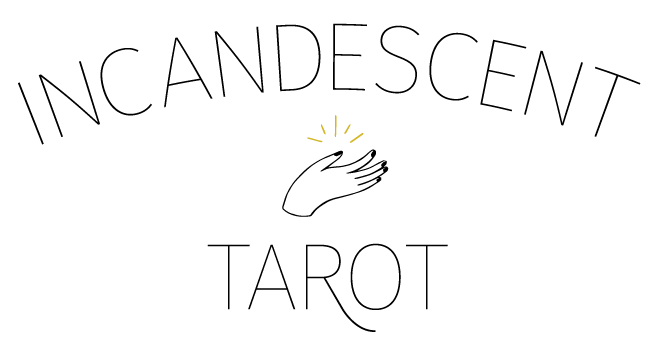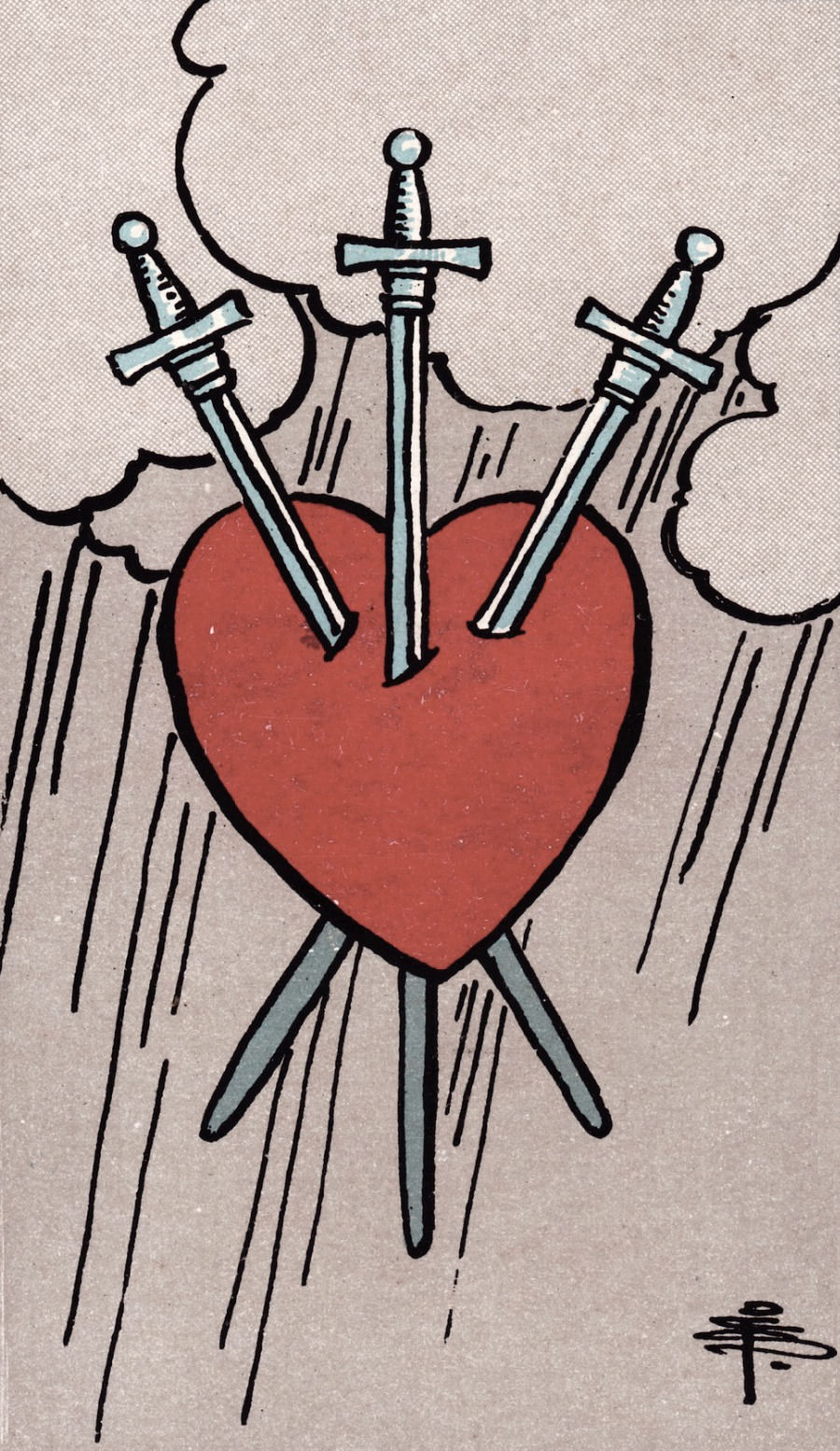Dealing with Difficult Tarot Cards: 7 Tips for Reading for Others
At our last Tarot Club meeting we had a nice chat about how to handle the tougher cards when reading for others. Is putting a positive spin on them simply sugar-coating the message? What about when someone is already nervous about tarot? How do you explain The Devil in a "something to look forward to" position in a spread?
These are all rich and meaty questions that each deserve their own post. For today, I'll be diving into the issue of using positive interpretations for these darker cards.
Before we jump on in, a moment to clarify. When I say "darker cards" I'm referring to the heavy hitters in tarot, the cards most likely to pop up on a massively stereotypical fortuneteller's table in a horror movie: Death, The Devil, The Tower, and the Three of Swords. I mean, just take a gander at these beauties!
Right off the bat we can see similarities. A predilection for ominous black or flat grey, intense imagery you could easily imagine on the cover of a death metal album, and visual themes of suffering. No wonder those new to tarot get squeamish around these cards!
And yet would you be surprised if I told you that these are some of my favorite cards in the deck? Without the darker tarot cards the system itself would lack nuance and depth. Tarot is a beautiful illustration of all the facets of life, good and bad. And I say "good and bad" as a jumping off point - tarot is much more subtle than a simple binary; though it uses them to illustrate certain points it also invites us to shade in all the tones of grey that make up most of our human experiences. Sugarcoating them strips away their beautiful complexity and power to reflect our lives in their entirety.
And yet it's a fine line to walk: how do we breach the complex messages of these cards when reading for friends, acquantances, or people new to tarot?
Tips for Interpreting "Negative" Tarot Cards
1. Acknowledge Change
No one card shows a static situation. Life is constantly changing, and we are constantly changing, so no one is going to get stuck experiencing the stabby heartbreak of the Three of Swords forever (that would take some serious willpower!) I think a lot of the fear around tarot is that the cards will show you something bad that you're powerless to change. On the contrary, tarot shows us what energy and happenings are circulating in our lives. It's a map we can look at, interpret, and then choose how to navigate.
2. Cut to the Chase
So you're at a party and have decided to read cards for a few friends. You flip them all over and the second to last card is Death. Instead of going in order while your friend is nervously fixated on a tarot card that literally says "death" on it, wondering if it means she's going to die, jump stright to it with a quick explanation. "You've probably noticed this scary looking skeleton on horseback that says "Death" underneath. Don't worry, tarot is a rich symbolic system and this card doesn't mean you're going to die tomorrow! It can actually be quite beautiful - we'll get to it soon, but in the meantime do you have any questions about it?" (Note: you can use much more elegant language that I do here!)This method takes some of the anxiety out of the situation and diffuses tension so that the querent can be present during their reading.
3. Explain the Context
All tarot cards have their positive and negative sides and their strengths and weaknesses. The large part of a tarot reading lies in each card's relationships to the others in the spread. Context is key. So Death with the Three of Swords could represent a painful but necessary breakup, or The Tower followed by the Six of Wands could show an unexpected, drastic change clearing way for a creative breakthrough. Tying the more challenging cards to others in the spread is a wonderful way to acquaint your querent with the situation and allow them to see their more detailed meanings unfold.
4. Let the Querent Lead
I see tarot as a collaborative process, so the experience and interpretation of whomever you're reading for is an essential. Give your querent an opportunity to share their response and connections with the difficult card after you've given a brief explanation of meaning and context. Does it resonate for them? Let them lead the interpretation here and listen actively. This is a key step for those kind souls who might be tempted to sugarcoat too much in an effort to shield their querent from difficult emotions or situations. Many people actually find it relieving and healing to see tougher situations in their readings. They feel seen and empowered to survey the land and decide how they want to proceed. Giving them the space to decide whether they want to dive deeper into a card or not will both give them the reading they need in the moment and allow you to respond accordingly.
5. Focus on Choice
As I mentioned above, a tarot reading isn't an indictment on your future. It shows the energy active in the current situation and the likely outcome if we proceed as we are right now. If anything, tarot readings give us insight into the many paths we can take. Each card has guidance to offer (yes, even The Tower) and it all rests on how we choose to work with its energy. This is exciting news! Sharing the power of choice and the different avenues available with your querent is a beautiful way to bring the reading home. Returning to the issue of sugar-coating, this is an excellent way to balance the painful aspects of a card with ways to heal. For example, say The Tower appears in a past position, representing an unexpected layoff. It's important here to acknowledge the trauma of this experience. The Tower isn't a walk in the park, that's for sure. Again, let the querent guide you. Additionally, The Tower depicts a situation where structure has crumbled due to an outside force. The querent had no control over the sitution; the only thing they can control is how they emerge from the aftermath. Do they want to rebuild the tower? Build something else? Or pursue another path that's less structured? Leaving the querent with these options is both validating and empowering.
6. Relinquish Control
When we read tarot for others we're equal parts interpreter and conduit. Worrying about how others will interpret things is an expression of our egos. Are we worried we'll offend someone? Look stupid? Refocusing on the cards and their message helps alleviate these anxieties. What is the message of The Devil if we strip away our own nervousness? Let the cards guide the reading and reenvision yourself as a true tarot reader.
7. Focus on Respect
It's essential to center our readings around the mission of offering insight and empowerment. Furthermore, tarot readings should be done with respect for the autonomy and competence of the querent. There's nothing in a tarot reading that could completely undo the querent unless we're reading unethically or phrasing our reading like a proclamation. Trust that the message in the cards will resonate as it needs to with whomever you're reading for. And trust that they are competent people able to care for themselves. We've all weathered heartbreak and misfortune. It may hurt, but it makes us stronger and more experienced. What better way to engage with these sticky subjects than with a trusted friend or tarot reader, looking over an array of insightful cards?
How about you? How have you worked with these darker cards in readings for others? Share your comments below...















Do you ever complain about something so often that you catch yourself and wonder, “If I rant on about this so much, why on earth am I still doing it?”
That was me with Facebook and Instagram. Why was I using it? What was I doing on these apps if all it took was one drink to get me to wax poetic about how disconnected, envious, and distracted I felt while using them?